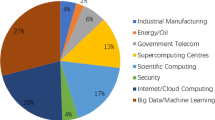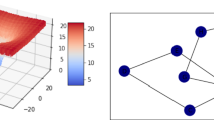Abstract
Data level parallelism is a type of parallelism whereby operations are performed on many data elements concurrently, by many processors. These operations are (more or less) identical, and are executed in a synchronous, orderly fashion. This type of parallelism is used by massively parallel SIMD (i.e., Single Instruction, Multiple Data) architectures, like the Connection Machine CM-2, the AMT DAP and Masspar, and MIMD (i.e., Multiple Instruction, Multiple Data) architectures, like the Connection Machine CM-5. Data parallelism can also be described by a theoretical model of computation: the Vector-Random Access Machine (V-RAM).
In this paper we discuss practical approaches to the data-parallel solution of large scale optimization problems with network—or embedded-network—structures. The following issues are addressed: (1) The concept of dataparallelism, (2) algorithmic principles that lead to data-parallel decomposition of optimization problems with network—or embedded-network—structures, (3) specific algorithms for several network problems, (4) data-structures needed for efficient implementations of the algorithms, and (5) empirical results that highlight the performance of the algorithms on a data-parallel computer, the Connection Machine CM-2.
Similar content being viewed by others
References
Amdahl, G., The validity of single processor approach to achieving large scale computing capabilities. InAFIPS Proceedings, volume 30, pages 483–485, 1967.
Balas, E., Miller, D., Pekny, J., and Toth, P., A parallel shortest path algorithm for the assignment problem. Management science technical report msrr 552, Carnegie Mellon University, 1989.
Benders, J.F., Partitioning procedures for solving mixed variables programming problems.Numerische Mathematik, 4:238–252, 1962.
Bertsekas, D.P., Distributed asynchronous relaxation methods for linear network flow problems. MIT report LIDS-P-1606, Nov. 1986.
Bertsekas, D.P. and El Baz, D., Distributed asynchronous relaxation methods for convex network flow problems.SIAM Journal on Control and Optimization, 25(1):74–85, 1987.
Bertsekas, D.P. and Eckstein, J.: Dual coordinate step methods for linear network flow problems.Mathematical Programming, 42(2):203–243, 1988.
Bertsekas, D.P., Distributed relaxation methods for linear network flow problems. InProc. 25th IEEE Conference on Decision and Control, pages 2101–2106, 1986.
Bertsekas, D.P., The auction algorithm: A distributed relaxation method for the assignment problem. InParallel Optimization on Novel Computer Architectures, Annals of Operations Research, volume 14, pages 105–124, 1988.
Bertsekas, D.P., Auction algorithms for network flow problems: a tutorial introduction.Computational Optimization and Applications, 1(1):7–66, 1992.
Bertsekas, D.P., Hossein, P., and Tseng, P., Relaxation methods for network flow problems with convex arc costs.SIAM Journal on Control and Optimization, 25:1219–1243, 1987.
Bertsekas, D.P. and J.N. Tsitsiklis.Parallel and Distributed Computation: Numerical Methods. Prentice Hall, Englewood Cliffs, New Jersey, 1989.
Blelloch, G.E.,Vector Models for Data Parallel Computing. The MIT Press, Cambridge, Massachusetts, 1990.
Bregman, L.M., The relaxation method for finding the common point of convex sets and its application to the solution of problems in convex programming.USSR Computational Mathematics and Mathematical Physics, 7:200–217, 1967.
Censor, Y. and Lent, A., An iterative row-action method for interval convex programming.Journal of Optimization Theory and Applications, 34:321–353, 1981.
Censor, Y., De Pierro, A.R., Elfving, T., Herman, G.T., and Iusem, A.N., On iterative methods for linearly constrained entropy maximization. In A. Wakulicz, editor,Numerical Analysis and Mathematical Modelling, volume 24, pages 145–163. Banach Center Publications, PWN-Polish Scientific Publisher, Warsaw, Poland, 1990.
Censor, Y. and Segman, J., On block-iterative entropy maximization.Journal of Information and Optimization Sciences, 8:275–291, 1987.
Censor, Y. and Zenios, S. A., Interval-constrained matrix balancing.Linear Algebra and Its Applications, 150:393–421, 1991.
Censor, Y. and Zenios, S. A., On the use ofD-functions in primal-dual methods and the proximal minimization algorithm. In A. Ioffe, M. Marcus, and S. Reich, editors,Optimization and Nonlinear Analysis, pages 76–97, London, 1992. Pitman Research Notes in Mathematics, Series 244, Longman.
Censor, Y. and Zenios, S.A., The proximal minimization algorithm withD-functions.Journal of Optimization Theory and Applications.73(3):455–468, 1992.
Censor, Y. and Zenios, S.A.,Introduction to methods of parallel optimization. Colóqui 190 Brasileiro de Matemática, Institute of Pure and Applied Mathematics, IMPA, Rio de Janeiro, Brazil, 1993.
Chajakis, E.D. and Zenios, S.A., Synchronous and asynchronous implementations of relaxation algorithms for nonlinear network optimization.Parallel Computing, 17:873–894, 1991.
Christofides, N., An algorithm for the chromatic number of a graph.The Computer Journal, 14(1):38–39, 1971.
Dembo, R.S., Mulvey, J.M., and Zenios, S.A., Large scale nonlinear network models and their application.Operations Research, 37:353–372, 1989.
Eckstein, J.,Splitting Methods for Monotone Operators with Applications to Parallel Optimization.PhD thesis, Department of Civil Engineering, MIT, Cambridge, MA, 1989.
Eckstein, J., Implementing and running the alternating step method on the Connection Machine CM-2.ORSA Journal on Computing, 5(1):84–96, 1993.
Eckstein, J. and Bertsekas, D.P., On the Douglas-Rachford splitting method and proximal point algorithm for maximal monotone operators.Mathematical Programming, 55(3):293–318, 1992.
Eckstein, J., Qi, R., Ragulin, V.I., and Zenios, S.A., Data parallel implementations of dense linear programming algorithms. Report 92-05-06, Decision Sciences Department, The Wharton School, University of Pennsylvania, Philadelphia, PA 19104, 1992.
Flynn, M.J., Some computer organizations and their effectiveness.IEEE Transactions on Computers, C 21:948–960, 1972.
Gabay, D. and Mercier, B., A dual algorithm for the solution of nonlinear variational inequalities via finite element approximations.Computational Mathematics and Applications, 2:17–48, 1976.
Glowinski, R. and Marocco, A., Sur l'approximation par elements d'ordre un et al resolution par penalisationdualite d'une class de problemes de dirichlet non lineaires.Revue Francaise d'Automatique Informatique et Recherche Operationnelle, 9(R22):41–76, 1975.
Goldberg, A. and Tarjan, R.E., Solving minimum-cost flow problems by successive approximations.Mathematics of Operations Research, 15(3):430–466, 1990.
Goldberg, A.V.,Efficient Graph Algorithms for Sequential and Parallel Computers. PhD thesis, Electrical Engineering and Computer Science, Massachusetts Insitute of Technology, Cambridge, MA, February 1987.
Goldberg, A. V., and Tarjan, R.E., A new approach to the maximum flow problem. InProceedings 18th ACM STOC., pages 134–146, 1986.
Habbal, M.B., Lerman, S.R., and Koutsopoulos, H.N., A decomposition algorithm for the all-pairs shortest path problem on massively parallel computer architectures. Working paper, Department of Civil Engineering, MIT, Cambridge, MA, 1991.
Hestenes, M.R., Multiplier and gradient methods.Journal of Optimization Theory and Applications, 4:303–320, 1969.
Journal of the American Academy of Arts and Sciences.Daedalus, Winter 1992.
Kempa, D., Kennington, J., and Zaki, H., Performance characteristics of the Jacobi and Gauus-Seidel versions of the auction algorithm on the Alliant FX/8.ORSA Journal on Computing, 3(2):92–106,1991.
Kennington, J.L. and Wang, Z., An empirical analysis of the dense assignment problem: sequential and parallel implementations.ORSA Journal on Computing, 3(4):299–306, 1991.
Klincewicz, J.G., Implementing an exact Newton method for separable convex transportation problems.Networks, 19:95–105, 1989.
Li, X. and Zenios, S. A., Data level parallel solution of min-cost network flow problems using ε-relaxations.European Journal of Operational Research. (to appear).
Li, X. and Zenios, S. A., A massively parallel ε-relaxation algorithm for linear transportation problems. In P.M. Pardalos, editor,Advances in Optimization and Parallel Computing, pages 164–176. Elsevier Science Publishers B.V., 1992.
Lustig, I.J., Mulvey, J.M., and Carpenter, T.J., Formulating two-stage stochastic programs for interior point methods.Operations Research, 39:757–770, 1991.
Mangasarian, O.L., and Meyer, R.R., Nonlinear perturbations of linear programs.SIAM Journal on Control and Optimization, 17:745–752, 1979.
Martinet, B., Regularisation d'inequations variationelles par approximations successives.Revue Francaise d'Automatique Informatique et Recherche Operationnelle,4:154–159, 1970.
McKenna, M. and Zenios, S. A., An optimal parallel implementation of a quadratic transportation algorithm. InFourth SIAM Conference on Parallel Processing for Scientific Computing, pages 357–363, Philadelphia, PA, 1990. SIAM.
Mulvey, J.M. and Vladimirou, H., Evaluation of a parallel hedging algorithm for stochastic network programming. In R. Sharda, B.L. Golden, E. Wasil, O.Balci, and W.Stewart, editors,Impact of Recent Computer Advances on Operations Research. Pergamon Press, 1989.
Mulvey, J.M. and Vladimirou, H., Stochastic network optimization models for investment planning.Annals of Operations Research, 20:187–217, 1989.
Murtagh, B.A. and Saunders, M.A., Minos user's guide. Report SOL 77-9, Department of Operations Research, Stanford University, California, 1977.
Nagurney, A., Kim, D-S., and Robinson, A.G., Serial and parallel equilibration of large-scale constrained matrix problems with application to the social and economic sciences.International Journal of Supercomputer Applications, 4:49–71, 1990.
Nielsen, S. and Zenios, S.A., Data structures for network algorithms on massively parallel architectures.Parallel Computing, 18:1033–1052, 1992.
Nielsen, S., and Zenios, S.A., Massively parallel algorithms for singly constrained convex programs.ORSA Journal on Computing, 4:166–181, 1992.
Nielsen, S. and Zenios, S.A., A massively parallel algorithm for nonlinear stochastic network problems.Operations Research, 41(2): 319–337, 1993.
Nielsen, S.S. and Zenios, S.A., Solving multistage stochastic network programs, Mathematical Programming, (to appear).
Nielsen, S.S. and Zenios, S.A., Proximal minimizations withD-functions and the massively parallel solution of linear network programs.Computational Optimization and Applications, 1 (4):375–398, 1993.
Nielsen, S.S. and Zenios, S.A., Proximal minimizations withD-functions and the massively parallel solution of linear stochastic network programs.International Journal of Supercomputing Applications, 1994. (to appear).
Phillips, C. and Zenios, S.A., Experiences with large scale network optimization on the Connection Machine. InThe Impact of Recent Computing Advances on Operations Research, volume 9, pages 169–180. Elsevier Science Publishing, 1989.
De Pierro, A.R. and Lusem, A.N., A relaxed version of Bregman's method for convex programming.Journal of Optimization Theory and Applications, 5:421–440, 1986.
Powell, M.J.D., A method for nonlinear constraints in minimization problems. In R.Fletcher, editor,Optimization, pages 283–298. Academic Press, 1969.
Qi, R-J. and Zenios, S.A., On the scalability of data parallel decomposition algorithms for stochastic programs.Journal of Parallel and Distributed Computing, 1994 (to appear).
Rockafellar, R.T., Augmented Lagrangians and applications to proximal point algorithms in convex programming.Mathematics of Operations Research, 1: 97–116, 1976.
Rockafellar, R.T., Monotone operators and the proximal point algorithm.SIAM Journal on Control and Optimization, 14:877–898, 1976.
Rockafellar, R.T.,Network Flows and Monotropic Programming. John Wiley, N. York, 1984.
Rockafellar, R.T. and Wets, R.J.-B., Scenarios and policy aggregation in optimization under uncertainty.Mathematics of Operations Research, 16:119–147, 1991.
Ruszczynski, A., A regularized decomposition method for minimizing a sum of polyhedral functions.Mathematical Programming, 35:309–333, 1986.
Schneider, M.H., Matrix scaling, entropy minimization and conjugate duality. I. Existence conditions.Linear Algebra and Its Applications, 114/115:785–813, 1989.
Schneider, M.H. and Zenios, S.A., A comparative study of algorithms for matrix balancing.Operations Research, 38:439–455, 1990.
Van Slyke, R.M. and Wets, R.J., L-shaped linear programs with applications to optimal control and stochastic programming.SIAM Journal of Applied Mathematics, 17:638–663, 1969.
Storoy S. and Sorevik, T., An SIMD, fine-grained, parallel algorithm for the dense linear assignment problems. Working paper, Department of Informatics, University of Bergen, Bergen, Norway, 1992.
Tseng, P., Dual ascent methods for problems with strictly convex costs and linear constraints: A unified approach.SIAM Journal on Control and Optimization, 28:214–242, Jan. 1990.
Wein, J. and Zenios, S.A., On the massively parallel solution of the assignment problem.Journal of Parallel and Distributed Computing, 13:228–236, 1991.
Wets, R.J.B., Stochastic programs with fixed resources: the equivalent deterministic problem.SIAM Review, 16:309–339, 1974.
Zaki, H., A comparison of two algorithms for the assignment problem. Technical report OR-90-002, Department of Mechanical and Industrial Engineering, University of Illinois, Champaign-Urbana, 1990.
Zenios, S.A. and Lasken, R.A., Nonlinear network optimization on a massively parallel Connection Machine.Annals of Operations Research, 14:147–165, 1988.
Zenios, S.A. and Mulvey, J.M., Relaxation techniques for strictly convex network problems.Annals of Operations Research, 5:517–538, 1986.
Zenios, S.A., Matrix balancing on a massively parallel Connection Machine.ORSA Journal on Computing, 2:112–125, 1990.
Zenios, S.A., On the fine-grain decomposition of multicommodity transportation problems.SIAM Journal on Optimization, 1(4):643–669, 1991.
Zenios, S.A. and Censor, Y., Massively parallel row-action algorithms for some nonlinear transportation problems.SIAM Journal on Optimization, 1:373–400, 1991.
Zenios, S.A. and Lasken, R.A., The Connection Machines CM-1 and CM-2: Solving nonlinear network problems. InACM International Conference on Supercomputing, pages 648–658, St. Malo, France, 1988.
Zenios, S.A., and Mulvey, J.M., A distributed algorithm for convex network optimization problems.Parallel Computing, 6:45–56, 1988.
Zenios, S.A., Qi, R., and Chajakis, E.D., A comparative study of parallel dual coordinate ascent implementations for nonlinear network optimization. In Coleman, T. and Li, Y., editors,Large Scale Numerical Optimization, pages 238–255. SIAM, 1990.
Stavros, Zenios, A., and Zenios, A. Stefanos, Robust optimization for matrix balancing from noisy data. Report 92-01-02, Decision Sciences Department, the Wharton School, University of Pennsylvania, Philadelphia, PA 19104, 1992.
Author information
Authors and Affiliations
Rights and permissions
About this article
Cite this article
Zenios, S.A. Data parallel computing for network-structured optimization problems. Comput Optim Applic 3, 199–242 (1994). https://doi.org/10.1007/BF01299446
Received:
Revised:
Issue Date:
DOI: https://doi.org/10.1007/BF01299446




